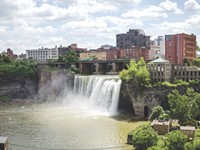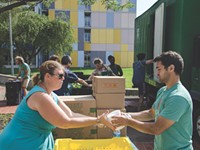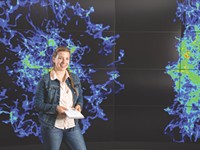[
{
"name": "500x250 Ad",
"insertPoint": "5",
"component": "15667920",
"parentWrapperClass": "",
"requiredCountToDisplay": "1"
}
]
With numerous area colleges, many of them more than a century old, it's easy to expect a few campus curiosities and legends to develop over time. Things like cavernous abandoned indoor pools, lucky albino rodents, and mysterious Underground Railroad tunnels have become part of the character of their campuses and the stories work their way into campus life.
Learning these tales will help in a student's understanding of their new home. To start, here are four campus oddities to keep an eye out for.
Do you know of an urban legend or curiosity surrounding a Rochester-area campus? Let us know in the comments section of this article online at rochestercitynewspaper.com.
Geneseo
Beneath Geneseo's Main Street are tunnels that were once used as part of the Underground Railroad. In the 1830's, a group of Congregationalists moved from New York City to Geneseo, and as one of their ranks, Harriet Cone Miller, wrote: "One of the articles of their creed was antagonism to human slavery. So practically the entire early population of the town was composed of abolitionists."
Today there are at least three houses on Geneseo's main street that have confirmed Underground Railroad hideaways. Generations of students living in Main Street residences have talked about closets in the basements that lead to passages — some of which are characterized as spooky, or even haunted.
In one alumni's words: "I lived at 45 Main for 2 years. Several of us ventured into the tunnel. At the far end of the basement facing towards the Big Tree Inn there were some missing concrete blocks and you could see further like it extended under Main Street. However, there was another wall made of older red brick that was intact. Not sure if it had anything to with the Underground Railroad, however I can say with certainty that regardless of whether there was a connection, the apartment was haunted."
Nazareth College
Nazareth College is nestled in the suburban periphery of Rochester. Local musician Cammy Enaharo, a one-time student there, brings up this Nazareth campus superstition: "There's a white squirrel that's famous on campus," she says. "When you see it you're supposed to have good luck or something."
University of Rochester
On the University of Rochester campus, the Merle Spurrier Gymnasium is home to a real oddity. Opened in 1955 as part of the women's center for the Susan B. Anthony women's dorm, the gym housed a 25-yard, six-lane swimming pool. When the women's gym facilities were moved to the Robert B. Goergen Athletic Center in 1982, the Spurrier building became an alternative exam location for large classes.
When exams weren't taking place, the pool became a depository for all sorts of extra desks and chairs and over time, the pool became an adopted home to more extraneous things the campus had no better place for. The university used the space for large boxes and equipment, and the Strong Auditorium kept an assortment of props in there like televisions and couches. Curious people who sought out the Spurrier pool found the cavernous room with assorted nonsense all over the deck of the pool, and the whole pool filled to the brim with desks, tables, chairs, and many more oddities. Today the building is home to the University Program of Movement & Dance and practice rooms for the music department, and as such the desks and chairs in the pool pretty much go ignored.
At some point in this room's history, there appeared a bunch of red-painted footprints all over the abandoned pool, the chairs and desks, the walls, and the tunnels that connect the gymnasium and the residence halls. The rumor, as it were, is that the footprints are those of Susan B. Anthony's ghost.
Eastman School of Music
Former Eastman School of Music student Maria Currie talks about one Eastman School of Music legend, in which George Eastman himself is buried "under the big dot in the Kilbourn hall entrance."
"This is untrue," Currie says, "and there is more than one dot — but people do say it to mess with new students." It might be a fun story to mess with freshmen, but in reality, George Eastman's ashes are buried on the grounds of Kodak Park, cased under a marble monument.
In This Guide...
Latest in Student Survival Guide
More by NOLAN H. PARKER
-

IRISH | Dallahan
Aug 19, 2015 -

DRINKS | Flour City Brewers Fest
Aug 19, 2015 -

FOOD | The Great American Backyard Burger and Rib Festival
Aug 19, 2015 - More »









